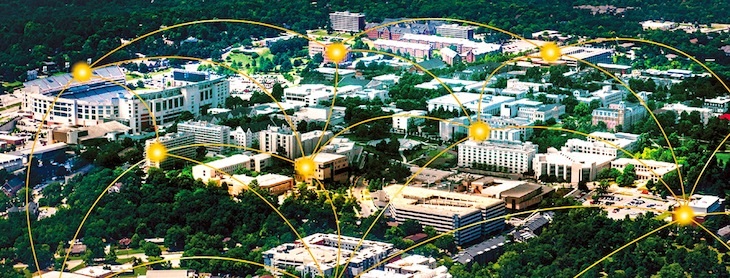Some Arkansas cities beginning to think about the tech future
by June 15, 2017 3:28 pm 1,526 views

First, there were smartphones, then smart homes. Now, tech watchers say smart cities are the wave of the future.
Smart cities use sensors, artificial intelligence, augmented reality and data analytics to make systems more efficient and enhance the resident experience, and the federal government is slated to spend $80 million this year toward research, infrastructure, grant programs and other initiatives tied to creating and supporting smart cities throughout the U.S.
International places with extensive smart city programs are Barcelona, Amsterdam, Copenhagen, Dubai, Singapore and Hamburg. India’s government has set a goal to develop 100 smart cities, according to a report from the market research company Frost & Sullivan.
Innovations in cities throughout the U.S., including New York City, Miami and Atlanta, are driven by the prospect of streamlining transportation, health and safety, security, air quality, energy efficiency, and water and waste management. Sensors can inform optimal traffic signal timing and can alert proper departments in real-time, for example, when bridges freeze or to report the water quality of Beaver Lake or Lake Fort Smith.
Technology can enable near-immediate reactions to events like gunshots and natural disasters. It can monitor large outdoor gatherings and alert authorities if the area is becoming too crowded and a riot seems imminent.
In San Antonio, streetlights adjust in stormy weather to improve visibility and reduce accidents, according to Tech Republic. The city also is connected to a broad smart infrastructure that links smart meters for electric, gas and water.
Chicago is using predictive analytics to determine which dumpsters are most likely to be full and therefore attract more rats, and it has resulted in 20% more efficiency in controlling the rodent population, the city’s chief data officer Tom Schenk said, according to Tech Republic. The city also uses analytics to dispatch food inspectors to the city’s 15,000 restaurants by using variables to predict which businesses are most likely to have code violations. In an eight-week trial of the program, code violations were found two weeks faster, on average, than they would have been without predictive analytics, Schenk said.
SMART TECH IN NORTHWEST ARKANSAS
Several dots need to connect before the smart city trend manifests in Arkansas — and funding sources for staff and equipment is a big one — but area municipalities are starting to take steps in that direction, said Fayetteville City Council member and real estate developer Matthew Petty.

The future is in data analytics, a key tenet of smart cities, Petty said. Data is widely used in the private sector, and cities have a massive amount of information at their disposal. The first step is having accessible, manageable information. Fayetteville now uses a software system that makes the city’s code more user-friendly and searchable, but Petty said “Municode is just barely scratching the surface.” The city could create an API (application programming interface) for its data, and software developers could then use it to design apps that would allow things like the city’s budget and collision data to be available for public consumption.
Northwest Arkansas is not there yet, though.
“It’s so brand new. Really only the biggest cities are looking at that,” Petty said. “Science for cities in general is brand new. … Most of the time decisions are made almost at the gut level,” based on a general consensus you get from a loose, non-technical canvassing of your constituents. “That will bubble up into a decision.”
Data can allow for more precision.
“It can touch people’s lives in ways we don’t even think of,” Petty said.
It can be used for outward-facing provision services, designed to make residents’ lives easier, and also for more behind-the-scenes work. Data can answer questions about the relative health for the restaurant market downtown, versus west Wedington or uptown — an analytic that is “a lot more useful” than looking at the popularity of individual restaurants, Petty said. And an aerial view of Fayetteville’s rooftops en masse, for example, can help the city scout potential locations for solar panel installation. Smart technology came in handy for recent planning efforts in Fayetteville, Petty said.
“We did an incredible level of analysis that wouldn’t have been possible even 10 years ago, or 14 years ago when the old plan was made.”
The city used body-heat detection maps provided by the private sector to gauge trail use, and a computer program that allowed officials to tweak a model of every street, sidewalk and bike trail in Fayetteville and watch the effect of traffic citywide, allowing analyzation of potential infrastructure changes.
TRAFFIC FIXES
Some cities have technology that analyzes street use patterns and makes adjustments to traffic light timing. Petty said using smart city technology to ease congestion points for drivers might be a good place to start in NWA.
“Traffic is the lowest hanging fruit for cities,” he said.
Last year, 78 cities competed in the U.S. Department of Transportation’s smart city challenge, where millions of dollars were awarded to help fund smart city transportation plans. Technology that helps users find open parking spots is one area Petty can see Fayetteville moving into within the next couple of years for its downtown. The innovation is now being used in San Francisco, according to ZDNet, where anyone with access to a smartphone app can see real-time data on available parking.
An estimated 30% of traffic in urban areas is caused by cars looking for parking, according to the DOT. Sensors can be placed underground, or they can be imbedded in lights, a more cost-effective option.
Sensor technology is already being used for parking at the University of Arkansas campus, but in a different capacity. The school has launched a pilot program that replaces parking permits with electronic beacons in license plates. Parking monitor staff will drive through lots and use vehicle-mounted cameras to identify unauthorized vehicles by scanning plates.
Foot traffic can also be monitored. In Florida, an organization is launching a program that will install hundreds of smart streetlights equipped with sensors to gauge pedestrian activity, a relevant piece of information for businesses that might want to move into the area.
While cities throughout the world are in various stages of smart city implementation, perhaps the greatest experiment for the concept is in South Korea, where private developers have built a $35 million, 1,500-acre smart city from the ground up, according to Tech Republic. There are no wires in the city. They are all underground. In lieu of garbage trucks, waste is transmitted underground through a pneumatic process. In homes, parents can connect to schools and talk to teachers through telepresence, according to Tech Republic. The city reports it has cut energy and water use by 30% compared to what a similarly sized city without smart features would use.
CREATING RESILIENCY
Smart cities have always been about creating resiliency, said Daniel Hintz, CEO of The Velocity Group in Bentonville. Years ago, that meant constructing buildings that could stand the test of the time and could be reused with different form and function.
“Downtown made the best investment. A building could have 27 lives, versus a one-off building that is 110,000 square feet and does not have a lot of other uses,” he said. “During the next 50 years, we can’t build in the same way as we did in the last 50.”
Now, longevity is about building tech infrastructure that will still be relevant 10, 15 or 20 years from now.
“Pound for pound, that’s a better investment,” Hintz said.
It might require more funding up front, but it will ultimately save money when cities don’t have to dig up obsolete systems down the road.
“We build our communities around a type of economy.”
When economies were primarily agriculture-focused, city squares were the center of culture and commerce, but the industrial revolution spread cities out.
“People didn’t want to live right next to a factory,” Hintz said.
Post World War II, the mass adoption of automobiles helped usher in the popularity of suburbs, but with the rise of the service economy, people returned to cities. In North America, 82% live in urban areas, and urbanization is projected to continue, according to a 2014 report from the United Nations.
“Now, how does e-commerce impact the way we design where we live and how we live?” Hintz asked, adding that he doesn’t have the solution. “It’s a long-term question, and the answer has to be developed by a wide swath of people.”
More than anything, smart cities are connected. There are no silos for various departments, for example, and that type of collaboration is also needed city to city, and region to region, he said.
Philosophical issues like privacy, net neutrality and how information will be used all need to be addressed before the widespread application of data in the public sector. However, social media is already a major player, Hintz said. He was part of recent effort that used various platforms to engage the community and help form Springdale’s downtown master plan. A hashtag campaign encouraged users to post about their life and work downtown and to share ideas about potential development. The result was a “live tapestry of data” that helped inform the plan, while also giving a voice to constituents.
“This isn’t a dictatorship of the few,” Hintz said. “People will value the process if they hear their own voices in the story.”
